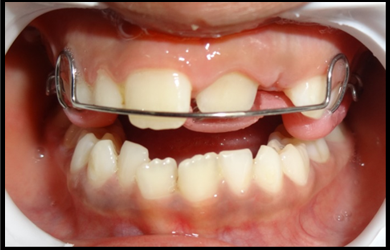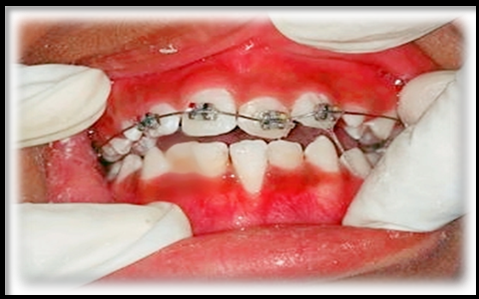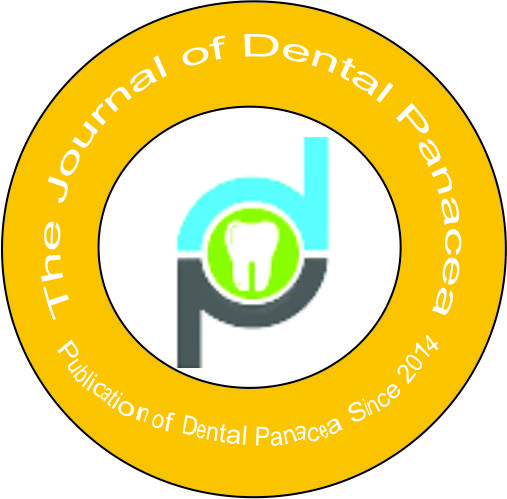- Visibility 158 Views
- Downloads 24 Downloads
- DOI 10.18231/j.jdp.2021.007
-
CrossMark
- Citation
Dental cross-bite: The paradigm of interception in orthodontics
- Author Details:
-
Megha Chawla *
-
Bhavna Gupta Saraf
-
Neha Sheoran
-
Saumya Paul
-
Siji Elizabeth
-
Shivani Singh
Introduction
A crossbite is a misalignment of the upper and lower teeth's buccolingual relationships. Crossbite is a common occurrence in orthodontic practice. If the lower teeth are in a buccal or labial location in relation to the upper teeth in a unilateral, bilateral, anterior and/or posterior manner, it can be clinically defined. Natural occlusion occurs when the palatine cusps of upper molars and premolars occlude in the fossa of lower molars and premolars in the transverse dimension.[1] Upper incisors occlude on the labial features of lower incisors in the anteroposterior plane. A skeletal or dental part, or a combination of both, may be present in crossbite malocclusion.
Anterior crossbite may occur in both primary and mixed dentition as a result of a misalignment of the child's structural, functional, and dental components. One or more anterosuperior teeth occlude behind the lingual feature of anteroinferior teeth in these condition.[2] One or two teeth are involved in dental anterior crossbite. In centric occlusion and centric relation, the profile is straight. The relationship of Class I molar and canine can be seen. Angles SNA, SNB, and ANB are all within standard ranges. It may be caused by an axial dental tendency that is irregular.[3]
Mandibular hyper propulsion, which causes a lower tongue position and a premature canine touch that entraps the upper maxilla, may cause pseudo Class III or functional anterior crossbite. The mandible is sometimes advanced mesially to achieve full intercuspation. In centric relation, the patient can achieve an edge-to-edge incisal relation. Molar and canine Class III relation in centric occlusion and centric relation define skeletal crossbite. In a centric relationship, there is no way to get an edge-to-edge incisor relationship. The cause of the malocclusion as well as the inclination of the affected teeth should be determined.[4]
Etiology
Etiology of a cross-bite deformity includes:[5]
Hereditary influence
Inadequate dental arch length
Over retained deciduous teeth
Supernumerary teeth
Habits like digit sucking
Skeletal-anteroposterior discrepancy of arches
Cleft lip and palate
Types of crossbite
Anterior crossbite ([Figure 2]) occurs when one or more of the upper incisors are in the linguo-occlusal position. Posterior crossbite occurs when the buccal cusps of upper molars and premolars overlap the lower teeth during occlusion, causing the lower teeth to overtake the upper teeth buccally. Subtypes of posterior crossbite are: Unilateral buccal crossbite with displacement, Unilateral buccal crossbite with no displacement, Bilateral buccal crossbite, Unilateral lingual crossbite and Bilateral lingual crossbite-scissor bite.



Epidemiology
In 2014, Bell and Kiebach[6] discovered posterior crossbite to be a prevalent disorder in deciduous and mixed dentition, with a prevalence of 5% to 8% in children aged 3 to 12. They also discovered a high prevalence of functional crossbite associated with transverse inconsistencies, with 90% of cases. Gungor et al. found a high prevalence of bilateral crossbite (51%) and unilateral crossbite on the right side (47.3%) and left side (53.6%) in the permanent dentition. [7]
Evaluation
Dental evaluation
Compensated Class III malocclusion must be recognised when the incisors are in edge-to-edge relation and the lower incisors are retroclined. Along with a functional evaluation, a clinical evaluation of under jet in relation to Class III molar relation should be performed.[8]
Functional evaluation
A functional evaluation of the relationship between the mandible and the maxilla should be done to decide whether there is any centric relation (CR) or centric occlusion discrepancy (CO).
Profile evaluation
An assessment of the facial proportions, jaw, and face positions is performed during a profile evaluation.
Cephalometric evaluation
Determine the location of the maxilla and mandible using cephalometric analysis.
Treatment of Crossbite
Anterior crossbite management-
As part of the diagnosis, presence or absence of anterior displacement from centric relation to centric occlusion during mandibular closure must be determined. Treatment, prognosis, and stability are both affected by the differentiation between real class III and pseudo class III malocclusions.[9]
Factors to consider when deciding on a treatment plan
What kind of movement is needed?
By the end of therapy, you can have an overbite.
Non-extraction vs. extraction cases
If the opposing tooth needed to pass over
It should be determined that what form of movement is needed for correction. Removable appliances may be used to help with tipping, while fixed appliances are used to help with bodily tooth movement. These features, as well as good anterior retention to counteract the active element's displaying influence, should be included in the appliance.[10] A bite plane or an active part to move the teeth could be used to free the occlusion with the opposing arch([Figure 2]). When there isn't enough overbite to keep the corrected incisors in place, fixed appliances might be recommended ([Figure 3]). Straight wire mechanics may use open coil springs to build enough arch length to position the teeth. For upper incisors that are palatally located, a negative root torque is often needed. The stability of retention is dependent on an appropriate overbite and a natural inclination of the long axis of the tooth to be handled.
Correction of Anterior Crossbite in Preadolescent age group
Using a tongue blade to correct a developing crossbite is an option. A tongue blade looks like a flat ice cream stick and is positioned inside the mouth on the palatal side of an erupting tooth in crossbite. The opposite side of the tooth comes into contact with the labial part of the opposing mandibular tooth during the slight closing of the jaws. During this time, light forces can assist the tooth in achieving a better position. [10]
The lower inclined plane, also known as Catalan's appliance, is built at a 45-degree angle to the maxillary occlusal plane and can be cemented on lower incisors. [11]
Correction of Anterior Crossbite in Adolescents and Adults-
Single or multiple tooth crossbite may be handled with fixed appliances.
Temporary Anchorage Devices are nowadays used as an option to treat crossbites. [12]
Posterior crossbite management
A coffin spring is an omega-shaped wire appliance that is used to fix crossbite in children's teeth. The expansion is gradual and symmetrical on both sides.
Quad helix is a permanent appliance that is soldered to molar bands that are cemented to the first permanent molars. It has a sluggish expansion rate and can be used in conjunction with a fixed appliance. [13]
The rapid maxillary expansion appliance involves hyrax screw capable of splitting the mid-palatine suture and brings about skeletal changes in a short interval. The RME screw can be incorporated into 2 types of appliances, the banded RME and bonded RME.
NiTi Expanders are nickel-titanium wire shapes that can be welded to molar bands cemented to the maxillary first permanent molars and attached to lingual sheath. There are several sizes to choose from, depending on the amount of expansion required and the width of the palate before surgery. [14]
Fixed orthodontic tools, which have three-dimensional control over the tooth, may be used to correct posterior crossbite. Depending on the movement needed, the arches may be kept slightly extended or constricted. Individual tooth crossbites in the posterior segment can be corrected with cross-elastics of 3/16-inch diameter exerting a force of 2.5 to 4.5 oz. [15]
Potential damage from untreated cross bite
Facets may occur on the labial enamel surface of locked upper incisor.
Excessively abrasion of both upper & lower incisor is common.
Inflammation & periodontal problems of mandibular incisors.
Loss of arch dimension.
Traumatic occlusion.
If the problem persists for a period of time leads to the TMJ disturbances. [16]
Conclusion
Timely intervention is better and less tedious in correction and if left untreated, it can cause growth modifications and dental compensations. It may eventually lead to a permanent deviation and craniofacial asymmetry as well as potentially deleterious masticatory patterns.
Conflicts of Interest
All contributing authors declare no conflicts of interest.
Source of Funding
None.
References
- R E Moyers. Handbook of Orthodontics. 1973. [Google Scholar]
- JH Park, TW Kim. Anterior crossbite correction with a series of clear removable appliances: A case report. J Esthet Restor Dent 2009. [Google Scholar]
- PW Major, K Glover. Treatment of anterior cross-bites in the early mixed dentition. J Can Dent Assoc 1992. [Google Scholar]
- S Bayrak, ES Tunc. Treatment of Anterior Dental Crossbite Using Bonded Resin-Composite Slopes: Case Reports. Eur J Dent 2008. [Google Scholar] [Crossref]
- K Heikinheimo, K Salmi, S Myllärniemi. Long term evaluation of orthodontic diagnoses made at the ages of 7 and 10 years. Eur J Orthod 1987. [Google Scholar]
- RA Bell, TJ Kiebach. Posterior crossbites in children: Developmental-based diagnosis and implications to normative growth patterns. Semin Orthod 2014. [Google Scholar] [Crossref]
- K Gungor, L Taner, E Kaygisiz. Prevalence of Posterior Crossbite for Orthodontic Treatment Timing. J Clin Pediatr Dent 2016. [Google Scholar] [Crossref]
- TM Graber. Company; 1972. Orthodontics Principles and Practice. 3th edn. 1972. [Google Scholar]
- G Vadiakas, AD Viazis. Anterior crossbite correction in the early deciduous dentition. Am J Orthod Dentofacial Orthop 1992. [Google Scholar] [Crossref]
- HA Kiyak. Patients’ and parents’ expectations from early treatment. Am J Orthod Dentofacial Orthop 2006. [Google Scholar] [Crossref]
- S. Sari, H. Gokalp, S. Aras. Correction of anterior dental crossbite with composite as an inclined plane. Int J Paediatr Dent 2001. [Google Scholar] [Crossref]
- T P Croll, R E Riesenberger. Anterior crossbite correction in the primary dentition using fixed inclined planes. II. Further examples and discussion. Quintessence Int 1988. [Google Scholar]
- T P Croll. Correction of anterior tooth crossbite with bonded resin-composite slopes. Quintessence Int 1996. [Google Scholar]
- H W Fields, WR Proffit. Treatment of nonskeletal problems in preadolescent children. Contemporary Orthodontics. 4th Edn. 2007. [Google Scholar]
- H W Fields, WR Proffit. Biomechanics, mechanics, and contemporary orthodontic appliences. Contemporary Orthodontics. 4th edn. 2007. [Google Scholar]
- W Proffit, F Henry, B Larson, D Sarver. Contemporary Orthodontics. 6th Edn. 2018. [Google Scholar]
- Introduction
- Etiology
- Epidemiology
- Evaluation
- Treatment of Crossbite
- Anterior crossbite management-
- Factors to consider when deciding on a treatment plan
- Correction of Anterior Crossbite in Preadolescent age group
- Correction of Anterior Crossbite in Adolescents and Adults-
- Posterior crossbite management
- Potential damage from untreated cross bite
- Conclusion
- Conflicts of Interest
- Source of Funding
